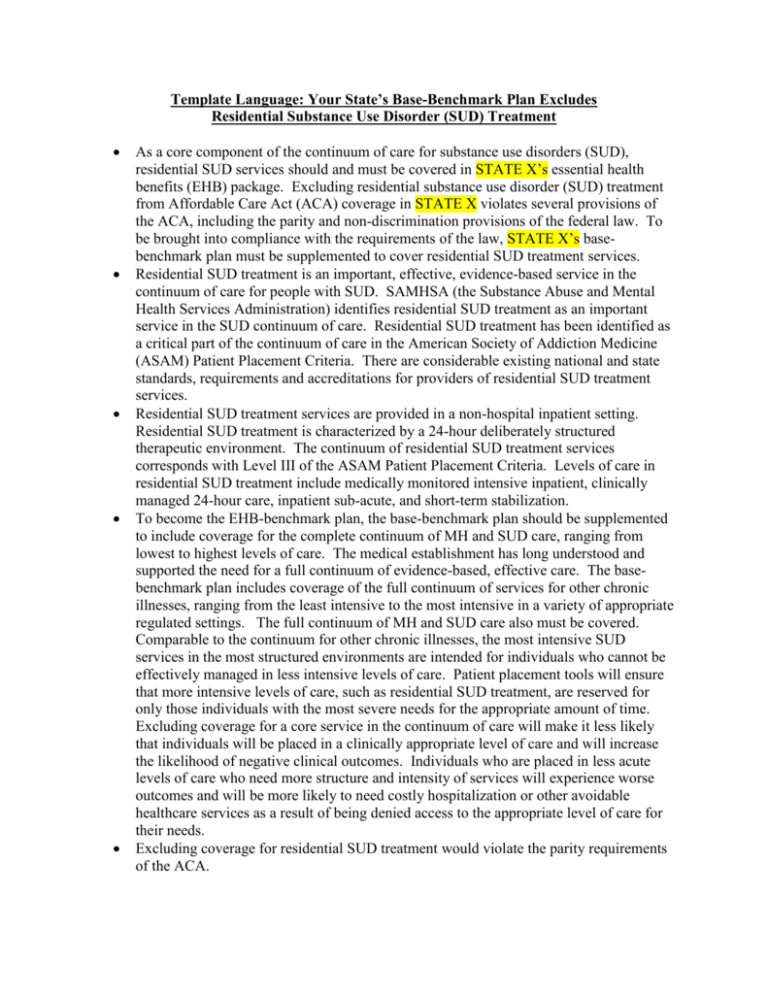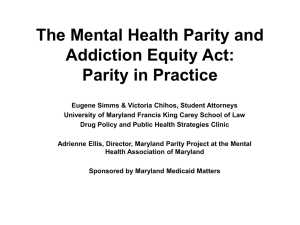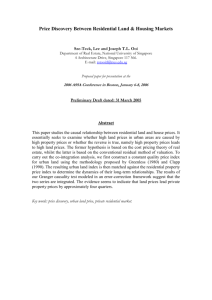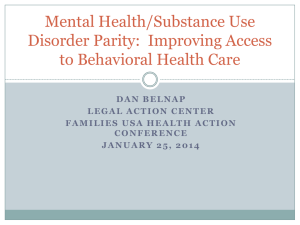Your State`s Base-Benchmark Plan Excludes Residential Substance
advertisement

Template Language: Your State’s Base-Benchmark Plan Excludes Residential Substance Use Disorder (SUD) Treatment As a core component of the continuum of care for substance use disorders (SUD), residential SUD services should and must be covered in STATE X’s essential health benefits (EHB) package. Excluding residential substance use disorder (SUD) treatment from Affordable Care Act (ACA) coverage in STATE X violates several provisions of the ACA, including the parity and non-discrimination provisions of the federal law. To be brought into compliance with the requirements of the law, STATE X’s basebenchmark plan must be supplemented to cover residential SUD treatment services. Residential SUD treatment is an important, effective, evidence-based service in the continuum of care for people with SUD. SAMHSA (the Substance Abuse and Mental Health Services Administration) identifies residential SUD treatment as an important service in the SUD continuum of care. Residential SUD treatment has been identified as a critical part of the continuum of care in the American Society of Addiction Medicine (ASAM) Patient Placement Criteria. There are considerable existing national and state standards, requirements and accreditations for providers of residential SUD treatment services. Residential SUD treatment services are provided in a non-hospital inpatient setting. Residential SUD treatment is characterized by a 24-hour deliberately structured therapeutic environment. The continuum of residential SUD treatment services corresponds with Level III of the ASAM Patient Placement Criteria. Levels of care in residential SUD treatment include medically monitored intensive inpatient, clinically managed 24-hour care, inpatient sub-acute, and short-term stabilization. To become the EHB-benchmark plan, the base-benchmark plan should be supplemented to include coverage for the complete continuum of MH and SUD care, ranging from lowest to highest levels of care. The medical establishment has long understood and supported the need for a full continuum of evidence-based, effective care. The basebenchmark plan includes coverage of the full continuum of services for other chronic illnesses, ranging from the least intensive to the most intensive in a variety of appropriate regulated settings. The full continuum of MH and SUD care also must be covered. Comparable to the continuum for other chronic illnesses, the most intensive SUD services in the most structured environments are intended for individuals who cannot be effectively managed in less intensive levels of care. Patient placement tools will ensure that more intensive levels of care, such as residential SUD treatment, are reserved for only those individuals with the most severe needs for the appropriate amount of time. Excluding coverage for a core service in the continuum of care will make it less likely that individuals will be placed in a clinically appropriate level of care and will increase the likelihood of negative clinical outcomes. Individuals who are placed in less acute levels of care who need more structure and intensity of services will experience worse outcomes and will be more likely to need costly hospitalization or other avoidable healthcare services as a result of being denied access to the appropriate level of care for their needs. Excluding coverage for residential SUD treatment would violate the parity requirements of the ACA. o First, under the parity requirements of the ACA, a plan’s MH/SUD coverage must meet standards of clinical practice. Residential SUD treatment is identified by ASAM and other SUD experts (include specific mention of any medical bodies/clinical guidelines in STATE X) as a critical service in the continuum of substance use care. Excluding coverage for a service that is widely held to be an integral part of the continuum of care is contrary to established national standards of care and accordingly violates parity. o In addition, the base-benchmark plan’s exclusion of residential SUD treatment does not meet MH/SUD parity requirements since it fails to cover SUD services provided in a non-hospital inpatient setting while covering services for other chronic diseases that are provided in comparable non-hospital inpatient settings. Residential SUD treatment services have a similar degree of intensity to those provided in other non-hospital inpatient facilities for people recovering from other medical conditions. Under the base-benchmark plan, individuals who are determined to need care in a non-hospital inpatient facility for a chronic disease such as heart disease, stroke or diabetes would be covered. SUD services in a comparable non-hospital inpatient setting are excluded from coverage, severely restricting access to the clinically appropriate level and setting of care. This disparate coverage for SUD care violates the ACA parity requirements. o If the base-benchmark in you state is a small group plan: As a small group plan, STATE X’s base-benchmark has not had to comply with the federal parity law and will very likely need to be supplemented to meet the parity requirements of the EHB. Plan documents for the base-benchmark plan suggest that the exclusion of residential SUD treatment in STATE X’s EHB would violate other parity requirements of the ACA. To complete a more thorough parity analysis, stakeholders in STATE X need to examine the plan’s medical necessity criteria used to exclude residential SUD treatment and compare that with the criteria used to determine coverage for similar levels of care covered for other medical conditions. Under the parity requirements of the ACA, if the criteria used to determine which MH and SUD services should be covered in the base-benchmark is different from and/or applied more stringently than the criteria used to determine coverage for other medical/surgical benefits in the plan, the MH and SUD benefits in the base-benchmark would need to be supplemented to comply with the EHB’s parity requirement. o If the base-benchmark in your state is a large group plan: Plan documents for the base-benchmark plan suggest other parity violations in the exclusion of residential SUD treatment. To complete a more thorough parity analysis, stakeholders in STATE X need to examine the plan’s medical necessity criteria used to exclude residential SUD treatment and compare that with the criteria used to determine coverage for similar levels of care covered for other medical conditions. Under the parity requirements of the ACA, if the criteria used to determine which MH and SUD services should be covered in the base-benchmark is different from and/or applied more stringently than the criteria used to determine coverage for other medical/surgical benefits in the plan, the MH and SUD benefits in the basebenchmark would need to be supplemented to comply with the EHB’s parity requirement. Excluding from coverage residential SUD treatment is contradictory to the ACA’s nondiscrimination requirements that the EHB address the healthcare needs of diverse segments of the population. Residential SUD treatment services are clinically appropriate for certain individuals with serious substance use disorders. Failing to provide coverage for an essential level of care for people with the disease of addiction, while covering comparable levels of care for individuals with other illnesses, is discriminatory toward those ill, disabled individuals. Since the benefits offered in the base-benchmark plan exclude certain services and medications that are effective, consistent with recognized standards of clinical care, and are beneficial to diverse groups of people, including people with MH and SUD service needs, this coverage fails to meet the non-discrimination requirements of the ACA and needs to be supplemented.







